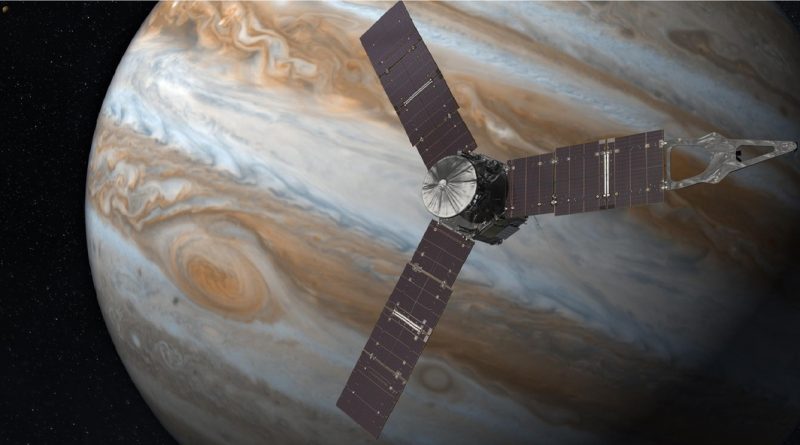Juno Spacecraft to Enter Jupiter Tonight
NASA’s Juno spacecraft is scheduled to enter into orbit around Jupiter Monday night (July 4), ending its nearly five-year trek to the solar system’s biggest planet.
The key event Monday is a 35-minute engine burn at 11:18 p.m. EDT (0318 GMT on Tuesday), which is designed to slow Juno down enough to be captured by Jupiter’s powerful gravity.
If something goes seriously wrong with this burn, the solar-powered Juno will zoom right past the gas giant, and the science goals of the $1.1 billion mission — which include mapping the gravitational and magnetic fields of Jupiter, and characterizing its internal structure — will go un-achieved.
Here’s a primer on how Juno’s highly anticipated Jupiter arrival should go down Monday night, along with a few notes about what to expect from the mission over the longer term.
9:16 p.m. EDT (0116 GMT) Monday: Juno begins slowly turning away from the sun and toward its orbit-insertion orientation. Another, faster turn toward this orientation begins at 10:28 p.m. EDT (0228 GMT). (These maneuvers and all other aspects of the orbital-insertion plan are pre-programmed; the spacecraft has been on autopilot since June 30.)
10:41 p.m. EDT (0241 GMT): Juno switches over to its low-gain antenna, which the probe will use to send status-updating “tones” during the night’s maneuvers, and fine-tunes its orbit-insertion attitude.
10:56 p.m. EDT (0256 GMT): The probe boosts its spin rate from 2 to 5 revolutions per minute (RPM) to increase its stability for the orbit-insertion burn.
11:18 p.m. EDT (0318 GMT): Juno’s main engine begins firing in the orbit-insertion burn, which should slow the spacecraft by 1,212 mph (1,950 km/h) and allow it to be captured by Jupiter’s gravity into a 53.5-day-long orbit.
11:53 p.m. EDT (0353 GMT): Orbit-insertion burn ends.
11:55 p.m. EDT (0355 GMT): Juno begins reducing its spin rate from 5 RPM back down to 2 RPM, a process that should take about 5 minutes.
12:07 a.m. EDT Tuesday (0407 GMT): The spacecraft begins pointing toward the sun again.
12:11 a.m. EDT (0411 GMT): Juno switches back to its medium-gain antenna.
12:16 a.m. EDT (0416 GMT): The probe starts beaming detailed telemetry information (not just tones) back to Earth. It will likely take about 20 minutes to lock onto Juno’s signal, mission team members have said. And data transmission will be far from instantaneous; it currently takes light about 48 minutes to travel from Jupiter back to Earth.
1 a.m. EDT (0500 GMT): NASA and Juno team members will hold a news conference to provide an update about how the orbital insertion went.
